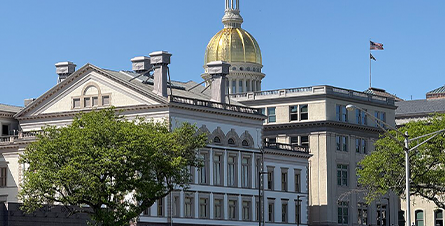Managing the Economic Load of PFAS Contamination on U.S. Utilities
7.8.24
Public water and wastewater systems are some of the hardest-working organizations in the country. With limited budgets and staff, they work tirelessly to protect public health for steadily increasing populations while complying with evolving regulations for emerging contaminants. In recent years, the widespread presence of persistent drinking water contaminants like per- and polyfluoroalkyl substances (PFAS) have become an increasing concern for many utilities. Known as “forever chemicals” for their tenacity in the environment, these manmade chemicals were used in thousands of industrial, commercial, and consumer products. PFAS manufacturers failed to warn users and the government of their dangers, leading to extensive surface water and groundwater contamination as these chemicals infiltrated the environment. Now, new regulations will require PFAS to be removed at great cost to utilities and their ratepayers. Addressing these challenges requires a concerted effort from public utilities, policymakers, and the public to implement comprehensive strategies that ensure the sustainability of water resources for current and future generations.
New Regulations Will Increase PFAS Treatment Costs
Since 2021, the United States Environmental Protection Agency (EPA) has taken steps outlined in its PFAS Strategic Roadmap to reduce the public health risks of exposure to these chemicals. In April 2024, the first-ever legally enforceable EPA drinking water standards were finalized. Under the Safe Drinking Water Act, EPA now regulates PFAS in public water systems through National Primary Drinking Water Regulations (NPDWR). The new NPDWR sets maximum contaminant levels (MCLs) for six different PFAS compounds. Public water systems have three years to initiate PFAS monitoring and must inform the public of detected levels. If PFAS levels exceed MCLs, systems must implement water treatment solutions or find alternative water sources to reduce contaminant concentrations within five years. The drinking water treatment processes and other mitigation strategies utilities will need to implement are projected to cost billions of US dollars.
EPA’s PFAS regulations didn’t stop with the new NPDWR. In fact, EPA also classified PFOA and PFOS—two common PFAS compounds—as “hazardous substances” under the Comprehensive Environmental Response, Compensation and Liability Act (CERCLA), also known as the “Superfund.” This move aims to bolster accountability for local manufacturers and other polluters releasing PFAS into the environment. But it also imposes hefty financial challenges on publicly owned treatment works (POTWs), exposing them to potential liabilities and cleanup expenses for PFAS in biosolids and treated wastewater discharge. As passive recipients of these contaminants, these facilities nevertheless face escalating treatment and disposal costs.
State Water Regulations Add Pressure for Utilities
In addition to the regulatory efforts at the federal level, several states across the U.S. are taking a proactive approach and proposing and/or setting their own PFAS wastewater and biosolids monitoring guidelines. Some states are taking regulations a step further and banning the land application of biosolids altogether. For example, in 2022, Maine passed legislation prohibiting the land application of sludge generated from municipal, commercial, or industrial wastewater treatment plants. Maryland has proposed regulation that would require major industrial dischargers to test for and pretreat PFAS present in wastewater before discharging effluent to community WWTPs, and the Maryland Department of the Environment is currently investigating PFAS concentrations in Class A and B biosolids and will potentially follow Maine’s rules based on its findings and require PFAS testing of biosolids before approving land application. New York, a leader in water regulation, set some of the nation's strictest PFAS drinking water standards even before EPA’s guidelines. More recently, New York's legislative efforts, like the proposed PFAS Discharge Disclosure Act (S227B), aim to extend stringent monitoring requirements for PFAS in wastewater. If passed, this law would be a national first, demanding comprehensive PFAS testing from a broad spectrum of discharge permit holders, including POTWs who would have to report PFAS levels in their effluent.
Will Federal and State Grants Cover PFAS Mitigation Costs?
Unfortunately, federal and state funding will only cover part of the costs of these regulatory mandates. On the federal front, President Biden’s Infrastructure Investment and Jobs Act has earmarked $22 billion for clean water initiatives—a substantial but insufficient sum for the PFAS treatment overhaul needed.
Many entities seeking to close remaining funding gaps have turned to litigation as a crucial component of their cost recovery strategy. Environmental law firms with experience in water contamination litigation work to prevent the cost of treating water contaminated through others’ irresponsible actions from being borne by utilities and their customers. The work of such firms has been effective in helping water and wastewater systems hold manufacturers accountable for the harm they caused to drinking water and natural resources.
Cost Recovery Litigation as an Alternative Funding Strategy
SL Environmental Law Group is a firm solely focused on water contamination litigation. Our efforts to help utilities recover PFAS costs began more than seven years ago and eventually led to the Aqueous Film-Forming Foam (AFFF) multi-district litigation (MDL). This MDL consolidated hundreds of PFAS lawsuits nationwide, including claims by public water providers, wastewater operators, airports, other property owners, and sovereign entities (including states, territories, and tribes) seeking to hold PFAS manufacturers accountable for the contamination. Fast-forward to June 2023, and DuPont (and its affiliates Chemours and Corteva) proposed a settlement of more than $1.18 billion to U.S. public water providers. This was shortly followed by 3M’s $12.5 billion proposal to settle public water system claims. Both settlements are now final, marking significant steps in the fight against PFAS.
SL has represented hundreds of clients since our inception in 2003, including municipal and investor-owned water utilities, cities, and state governments in lawsuits against the manufacturers whose products have contaminated their water supplies, wastewater systems, or other resources. We are currently assisting more than 200 clients affected by PFAS contamination.
Learn About Available Cost Recovery Methods
If your utility is experiencing funding concerns due to rapidly evolving PFAS regulations, know that you have options for cost recovery. Through innovative funding solutions, your utility can navigate the complex regulatory environment without imposing undue financial strain on ratepayers. To learn more about your water or wastewater system's options, schedule a free consultation with our PFAS litigation team.



